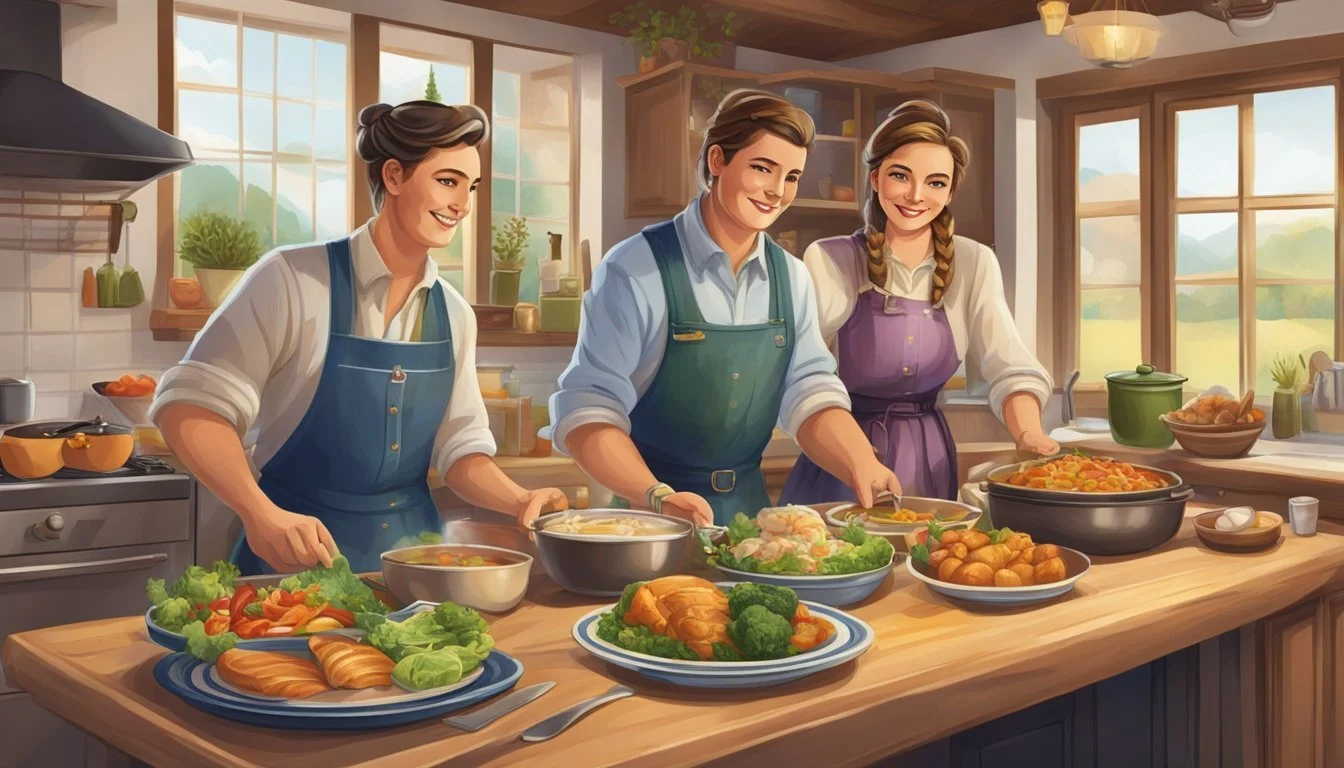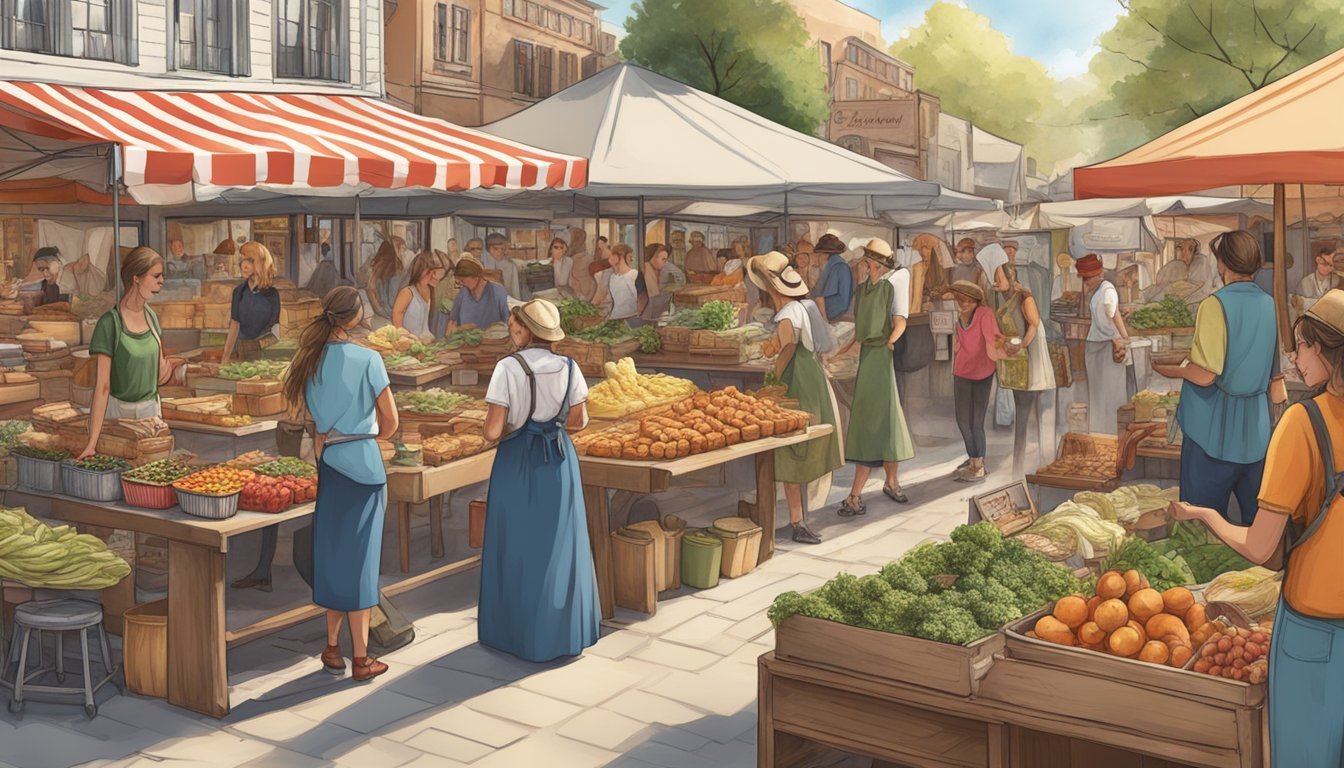German Texan Food and Fashion Collaborations
Blending Cultures in Style
The fusion of German influences with Texan culture has given rise to a unique culinary and fashion scene that celebrates the best of both worlds. Germans who settled in Texas left a lasting legacy not just through their time-honored traditions and architecture but also through their substantial impact on Texan food. Dishes that have become staples in the Lone Star State carry hints of German origins, intertwining the robust flavors and hearty characteristics of both cultures. In kitchens across Texas, this blend is characterized by a reverence for ingredients like brisket—a cut of meat embraced with zeal in both barbecue and German-inspired cuisines.
Fashion, too, has been touched by this cross-cultural exchange. Events such as Oktoberfest have fostered a space where German and Texan styles meet, with lederhosen mingling with cowboy boots and hats, and dirndls alongside sundresses. This blend is more than a simple juxtaposition of attire; it represents a collaborative spirit that honors heritage while crafting something entirely new.
Collaborations between German Texan food and fashion industries embody a trend where the line between gastronomy and apparel becomes delightfully blurred. Social media influencers and local events showcase this trend, bringing together food-inspired fashion and culinary ensembles that appeal to the lifestyle-oriented Gen Z demographic. Together, these industries are forging a path that captures the imagination and palate, providing a taste of innovation that is both authentic and refreshingly modern.
Historical Context and Immigration
The early to mid-19th century saw significant German immigration to Texas, where these European settlers established communities and infused their rich cultural heritage into the Texan landscape.
German Settlement in Texas
Texas became a prime destination for German migrants in the 1830s through the efforts of societies like the Adelsverein, organized to support the migration and settlement of German people in Texas. The man behind this visionary plan was Prince Carl of Solms-Braunfels who, in 1844, led the first settlers to the Texas region. Historic towns like Fredericksburg and New Braunfels were founded by these German immigrants, who were attracted to the lush, rolling hills reminiscent of their homeland.
Key Figures:
Prince Carl of Solms-Braunfels
John O. Meusebach
Major Settlements:
Fredericksburg, established 1846
New Braunfels, established 1845
Cultural Integration and Influence
Germans brought their skills, traditions, and aspects of their German culture to Central Texas, substantially influencing the local lifestyle. Their legacy is seen in the Texas Hill Country, where they contributed to agriculture, education, and the arts. The German Free School, founded in the mid-19th century, became a symbol of German contribution to education in Texas. The fusion of German and Texan culture has endured, shaping a unique identity, particularly evident in the food and fashion of the region.
Cultural Contributions:
Education: German Free School
Architecture: Distinctive styles in communities
Cuisine: German-Texan culinary fusion
German immigration, with its significant cultural influence, has left an indelible mark on Texan society, creating a distinctive blend of heritage which is celebrated throughout the state.
Culinary Legacy of German Texans
The German Texans' culinary contributions distinctly enhance Texan cuisine through their indigenous German cooking techniques and ingredients. This fusion of tastes not only enriches the local food culture but also stands as a testament to the lasting heritage of German settlers in Texas.
Influence on Texan Cuisine
German settlers brought a wealth of culinary traditions to Texas, integrating their skills in baking and meat preparation with local ingredients. Central to this influence are sausages and breads, staples of German cuisine (What Wine Pairs Perfectly With German Cuisine) that have been adapted and remain popular in Texas. Texas barbecue, known for its emphasis on smoked and slow-cooked meats, also shows hints of German heritage, especially through the use of beef and pork. German-style meats, often accompanied by sauerkraut and potato salads, comfortably coexist with southern staples in Texan dining.
Tex-Mex and German Fusion
The intersection of German and Mexican culinary traditions in Texas has led to unique Tex-Mex fusion dishes. Ingredients like brisket, a near-celebrity in Texas barbecue, merge with Mexican culinary customs, resulting in creations such as brisket-filled tacos or enchiladas with a German twist, like adding a cream gravy. Staples such as potatoes, turned into Mexican-style potato pancakes, display the versatility and harmonious blending of these two rich food cultures.
Famous German-Texan Eateries
Diverse eateries across Texas boast a German culinary influence:
Scholz Garten in Austin: Established in 1866, it is renowned for its vibrant beer garden atmosphere and traditional German dishes with Texan flair.
Alpine Haus in New Braunfels: Offers authentic German fare coupled with Texan tastes, serving items like schnitzel alongside Texas classics.
Little Gretel in Boerne: Combines the cozy charm of Czech and German recipes with the robust flavors of Texas.
Der Lindenbaum in Fredericksburg: A place where you can savor traditional German dishes such as sauerbraten in the heart of Texas wine country.
Fashion Contributions and Texan Identity
In examining the influence of German culture on Texan fashion, one can trace a line from traditional garb to the vibrant styles seen at contemporary cultural festivals.
Traditional and Contemporary Attire
German Texan fashion roots itself deeply in traditions, with particular garments such as lederhosen and dirndls embodying a lasting heritage. Lederhosen, leather breeches traditionally worn by men, paired with suspenders and sometimes knee-socks, still make appearances in Texas, especially during festivals. Modern adaptations of these garments offer a nod to historical German attire while incorporating Texan flair, such as cowboy boots or hats.
Women's traditional dirndls have also seen a resurgence. They typically consist of a bodice, a blouse, a full skirt, and an apron. Contemporary Texan fashion designers might blend these elements with local fabrics and patterns, illustrating a fusion between old-world German style and Texan sensibilities.
Cultural Festivals and Dress
Cultural festivals in Texas, like Oktoberfest and Wurstfest, bring German traditional fashion to the forefront, serving as a canvas for Texan identity expression through dress. Wurstfest in New Braunfels, for instance, is an annual celebration where attendees often don traditional Bavarian attire as part of the festivities. Here’s a brief breakdown of what one might observe:
Men’s Attire: Often dressed in lederhosen with a checkered shirt, alpine hat, and boots.
Women’s Attire: Commonly seen in dirndls, that vary in colors and patterns, often accessorized with a matching apron and sometimes a flower crown.
These events are not only a celebration of German Texan culture but also serve as a testament to the integration and evolution of German fashion into Texan life. They showcase a vibrant tapestry that weaves together the threads of heritage, culture, and community identity through the language of clothing.
Living Heritage and Community Life
Within German Texan communities, the blend of traditions and cultural elements is evident in architecture, festivities, and language. These aspects act as living testaments to the German heritage that continues to thrive in Texas.
Architecture and Settlements
German influence on Texan architecture is prominent in areas with significant German settlement history. Fredericksburg and New Braunfels stand as quintessential examples where German-style homes and public buildings mirror those of 19th-century Germany. These structures typically feature timber framing, use local stone such as limestone, and have steep gabled roofs. The careful planning of these communities also embraced the utilization of the local land, arranging homes and communal spaces in a manner that efficiently used the available resources.
Traditional Celebrations and Music
German Texan festivals and music remain vital expressions of cultural identity. Wurstfest in New Braunfels is one of the largest gatherings, drawing crowds keen to experience German music, particularly polka, alongside traditional dances.
Popular Festivals:
Wurstfest: Celebrating German cuisine, particularly sausage and beer.
Oktoberfest: Held in various towns, a homage to the famed Bavarian festival.
Music plays a central role, with polka bands using instruments like the accordion and tuba to create a lively atmosphere that encourages dancing and community cohesion.
Language Preservation and Dialects
The German language, which once risked fading, is experiencing a revival in Texan communities. Efforts to preserve the unique Texas German dialect are evident. Preservation is not only found in linguistic studies but also in its use at cultural festivals and through educational initiatives. The dialect is a fusion of various German dialects that immigrants brought with them, now adapted to the Texan environment and sprinkled with English terms, creating a unique linguistic tapestry.
Economic Impact and Development
The presence of German-Texan culture in Texas has historically left an indelible mark on the state's economy, notably through advancements in agriculture and brewing that catalyzed trade and infrastructure development.
Agriculture and Brewing
German settlers in Texas brought with them extensive knowledge of farming and viticulture, significantly affecting local agriculture. They cultivated a variety of crops that were both native to Texas and reminiscent of their homeland, leveraging the fertile Texan soil for growth. In the realm of brewing, Germans introduced their age-old traditions, leading to the establishment of several breweries. These breweries became economic staples in their communities, contributing to job creation and the proliferation of beer as a commercial product.
Crops: Cultivated by Germans in Texas
Wheat
Corn
Rye
Barley (used in brewing)
Prominent Breweries:
Spoetzl Brewery: Producers of Shiner beer, iconic in Texas
Fredericksburg Brewery: Renowned as one of the oldest brewpubs in the state
Trade and Infrastructure
The brewing industry, along with other agricultural pursuits, necessitated robust trade routes, stimulating infrastructure development. Railroads became integral to the economy, facilitating the distribution of agricultural goods and beer. These railroads not only connected German-Texan communities internally but also linked them to larger markets, enabling trade on a wider scale. Economic interaction through trade fostered further economic development and intercultural exchanges within Texas.
Infrastructure Contributions:
Railroads construction prompted by agricultural and brewery needs
Enhanced trade networks within Texas and across state lines
Trade Outcomes:
Growth of local and regional economies
Expansion of market reach for Texan products, including those from German-Texan communities






